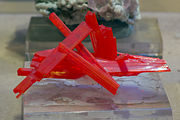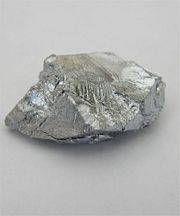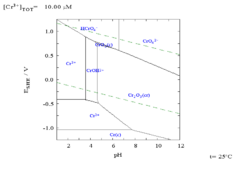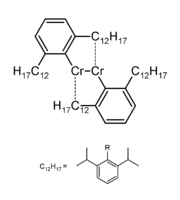Chromium
|
||||||||||||||||||||||||||||||||||||||||
| General | ||||||||||||||||||||||||||||||||||||||||
|---|---|---|---|---|---|---|---|---|---|---|---|---|---|---|---|---|---|---|---|---|---|---|---|---|---|---|---|---|---|---|---|---|---|---|---|---|---|---|---|---|
| Name, symbol, number | chromium, Cr, 24 | |||||||||||||||||||||||||||||||||||||||
| Element category | transition metal | |||||||||||||||||||||||||||||||||||||||
| Group, period, block | 6, 4, d | |||||||||||||||||||||||||||||||||||||||
| Appearance | silvery metallic |
|||||||||||||||||||||||||||||||||||||||
| Standard atomic weight | 51.9961(6) g·mol−1 | |||||||||||||||||||||||||||||||||||||||
| Electron configuration | [Ar] 3d5 4s1 | |||||||||||||||||||||||||||||||||||||||
| Electrons per shell | 2, 8, 13, 1 | |||||||||||||||||||||||||||||||||||||||
| Physical properties | ||||||||||||||||||||||||||||||||||||||||
| Phase | solid | |||||||||||||||||||||||||||||||||||||||
| Density (near r.t.) | 7.19 g·cm−3 | |||||||||||||||||||||||||||||||||||||||
| Liquid density at m.p. | 6.3 g·cm−3 | |||||||||||||||||||||||||||||||||||||||
| Melting point | 2180 K (1907 °C, 3465 °F) |
|||||||||||||||||||||||||||||||||||||||
| Boiling point | 2944 K (2671 °C, 4840 °F) |
|||||||||||||||||||||||||||||||||||||||
| Heat of fusion | 21.0 kJ·mol−1 | |||||||||||||||||||||||||||||||||||||||
| Heat of vaporization | 339.5 kJ·mol−1 | |||||||||||||||||||||||||||||||||||||||
| Specific heat capacity | (25 °C) 23.35 J·mol−1·K−1 | |||||||||||||||||||||||||||||||||||||||
|
||||||||||||||||||||||||||||||||||||||||
| Atomic properties | ||||||||||||||||||||||||||||||||||||||||
| Crystal structure | cubic body centered | |||||||||||||||||||||||||||||||||||||||
| Oxidation states | 6, 5 [2], 4, 3, 2, 1 (strongly acidic oxide) |
|||||||||||||||||||||||||||||||||||||||
| Electronegativity | 1.66 (Pauling scale) | |||||||||||||||||||||||||||||||||||||||
| Ionization energies (more) |
1st: 652.9 kJ·mol−1 | |||||||||||||||||||||||||||||||||||||||
| 2nd: 1590.6 kJ·mol−1 | ||||||||||||||||||||||||||||||||||||||||
| 3rd: 2987 kJ·mol−1 | ||||||||||||||||||||||||||||||||||||||||
| Atomic radius | 140 pm | |||||||||||||||||||||||||||||||||||||||
| Atomic radius (calc.) | 166 pm | |||||||||||||||||||||||||||||||||||||||
| Covalent radius | 127 pm | |||||||||||||||||||||||||||||||||||||||
| Miscellaneous | ||||||||||||||||||||||||||||||||||||||||
| Magnetic ordering | AFM (rather: SDW) | |||||||||||||||||||||||||||||||||||||||
| Electrical resistivity | (20 °C) 125 nΩ·m | |||||||||||||||||||||||||||||||||||||||
| Thermal conductivity | (300 K) 93.9 W·m−1·K−1 | |||||||||||||||||||||||||||||||||||||||
| Thermal expansion | (25 °C) 4.9 µm·m−1·K−1 | |||||||||||||||||||||||||||||||||||||||
| Speed of sound (thin rod) | (20 °C) 5940 m/s | |||||||||||||||||||||||||||||||||||||||
| Young's modulus | 279 GPa | |||||||||||||||||||||||||||||||||||||||
| Shear modulus | 115 GPa | |||||||||||||||||||||||||||||||||||||||
| Bulk modulus | 160 GPa | |||||||||||||||||||||||||||||||||||||||
| Poisson ratio | 0.21 | |||||||||||||||||||||||||||||||||||||||
| Mohs hardness | 8.5 | |||||||||||||||||||||||||||||||||||||||
| Vickers hardness | 1060 MPa | |||||||||||||||||||||||||||||||||||||||
| Brinell hardness | 1120 MPa | |||||||||||||||||||||||||||||||||||||||
| CAS registry number | 7440-47-3 | |||||||||||||||||||||||||||||||||||||||
| Selected isotopes | ||||||||||||||||||||||||||||||||||||||||
|
||||||||||||||||||||||||||||||||||||||||
| References | ||||||||||||||||||||||||||||||||||||||||
Chromium (pronounced /ˈkroʊmiəm/) is a chemical element which has the symbol Cr and atomic number 24. It is a steely-gray, lustrous, hard metal that takes a high polish and has a high melting point. It is also odourless, tasteless, and malleable. Chromium was named after the Greek word "Chrōma" (χρωμα) meaning color, because of the many colorful compounds made from it.[1]
Contents[hide] |
History
The history of chromium dates back thousands of years. Weapons found in burial pits dating from the late 3rd century BC Qin Dynasty of the Terracotta Army near Xi'an, China have been analyzed by archaeologists. Although buried more than 2,000 years ago, the ancient bronze tips of crossbow bolts and swords found at the site showed no sign of corrosion, because the bronze was coated with chromium.[2]

Chromium came to the attention of westerners in the 18th century. On 26 July 1761, Johann Gottlob Lehmann found an orange-red mineral in the Ural Mountains which he named Siberian red lead. Though misidentified as a lead compound with selenium and iron components, the material was lead chromate with a formula of PbCrO4, now known as the mineral crocoite.
In 1770, Peter Simon Pallas visited the same site as Lehmann and found a red lead mineral that had useful properties as a pigment in paints. The use of Siberian red lead as a paint pigment developed rapidly. A bright yellow made from crocoite also became fashionable.
In 1797, Louis Nicolas Vauquelin received samples of crocoite ore. He produced chromium oxide (CrO3) by mixing crocoite with hydrochloric acid. In 1798, Vauquelin discovered that he could isolate metallic chromium by heating the oxide in a charcoal oven.[3] He was also able to detect traces of chromium in precious gemstones, such as ruby, or emerald.
During the 1800s, chromium was primarily used as a component of paints and in tanning salts, but metal alloys now account for 85% of the use of chromium. The remainder is used in the chemical industry and refractory and foundry industries. chromium is also known well for its luster when polished, it is used for decoration ect.
Occurrence and production

Chromium is mined as chromite (FeCr2O4) ore. About two-fifths of the chromite ores and concentrates in the world are produced in South Africa, while Kazakhstan, India, Russia, and Turkey are also substantial producers. Untapped chromite deposits are plentiful, but geographically concentrated in Kazakhstan and southern Africa.
Approximately 15 million tons of marketable chromite ore were produced in 2000, and converted into approximately 4 million tons of ferro-chrome with an approximate market value of 2.5 billion United States dollars.
Though native chromium deposits are rare, some native chromium metal has been discovered. The Udachnaya Mine in Russia produces samples of the native metal. This mine is a kimberlite pipe rich in diamonds, and the reducing environment helped produce both elemental chromium and diamond. (See also chromium minerals)
Chromium is obtained commercially by heating the ore in the presence of aluminium or silicon.
Chemical properties

Chromium is a member of the transition metals, in group 6. Chromium(0) has an electronic configuration of 4s13d5, due to the lower energy of the high spin configuration. Chromium exhibits a wide range of possible oxidation states. The most common oxidation states of chromium are +2, +3, and +6, with +3 being the most stable. +1, +4 and +5 are rare. Chromium compounds of oxidation state +6 are powerful oxidants.
Chromium is passivated by oxygen, forming a thin protective oxide surface layer with another element such as nickel or iron. This layer is a spinel structure only a few atoms thick and is very dense, preventing diffusion of oxygen into the underlying material. (In iron or plain carbon steels the oxygen migrates into the underlying material.) Chromium is usually plated on top of a nickel layer which may first have been copper plated. Chromium, unlike metals such as iron and nickel, does not suffer from hydrogen embrittlement. It does suffer from nitrogen embrittlement and hence no straight chromium alloy has ever been developed. Below, the pourbaix diagram can be seen. It is important to understand that the diagram only displays the thermodynamic data and it does not display any details of the rates of reaction.

Compounds
Potassium dichromate is a powerful oxidizing agent and is the preferred compound for cleaning laboratory glassware of any trace organics. It is used as a saturated solution in concentrated sulfuric acid for washing the apparatus. For this purpose, however, sodium dichromate is sometimes used because of its higher solubility (5 g/100 ml vs. 20 g/100 ml respectively). Chrome green is the green oxide of chromium, Cr2O3, used in enamel painting, and glass staining. Chrome yellow is a brilliant yellow pigment, PbCrO4, used by painters.
Chromic acid has the hypothetical structure H2CrO4. Neither chromic nor dichromic acid is found in nature, but their anions are found in a variety of compounds. Chromium trioxide, CrO3, the acid anhydride of chromic acid, is sold industrially as "chromic acid".
Chromium and the quintuple bond

Chromium is notable for its ability to form quintuple covalent bonds. The synthesis of a compound of chromium(I) and a hydrocarbon radical was shown via X-ray diffraction to contain a quintuple bond of length 183.51(4) pm (1.835 angstroms) joining the two central chromium atoms.[5] This was accomplished through the use of an extremely bulky monodentate ligand which through its sheer size prevents further coordination. Chromium currently remains the only element for which quintuple bonds have been observed.
Applications
Uses of chromium:
- In metallurgy, to impart corrosion resistance, create a shiny finish, or increase hardness:
- as an alloy constituent, such as in stainless steel
- in chrome plating
- chromic acid is used in some anodizing processes
- As dyes and paints:
- As a catalyst.
- Chromite is used to make molds for the firing of bricks.
- Chromium salts are used in the tanning of leather.
- Potassium dichromate is a chemical reagent, used in cleaning laboratory glassware and as a titrating agent. It is also used as a mordant (i.e., a fixing agent) for dyes in fabric.
- Chromium(IV) oxide (CrO2) is used to manufacture magnetic tape, where its higher coercivity than iron oxide tapes gives better performance.
- In well drilling muds as an anti-corrosive.
- In medicine, as a dietary supplement or slimming aid, usually as chromium(III) chloride, chromium(III) picolinate, chromium(III) polynicotinate or as an amino acid chelate, such as chromium(III) D-phenylalanine.[6]
- Chromium hexacarbonyl (Cr(CO)6) is used as a gasoline additive.
- Chromium boride (CrB) is used as a high-temperature electrical conductor.
- Chromium(III) sulfate (Cr2(SO4)3) is used as a green pigment in paints, in ceramic, varnishes and inks as well as in chrome plating.
- Chromium(VI) is used in the post Ballard preparation of Gravure (rotogravure) printing Forme Cylinders. By electroplating the metal onto the second coat of copper (after the Ballard skin), the longevity of the printing cylinder is increased.
Biological role
Trivalent chromium (Cr(III) or Cr3+) is required in trace amounts for sugar metabolism in humans (Glucose Tolerance Factor) and its deficiency may cause a disease called chromium deficiency. In contrast, hexavalent chromium (Cr(VI) or Cr6+) is very toxic and mutagenic when inhaled, as publicized by the film Erin Brockovich. Cr(VI) has not been established as a carcinogen when in solution, though it may cause allergic contact dermatitis (ACD).[7]
The popular dietary supplement chromium picolinate complex generates chromosome damage in hamster cells.[8] In the United States the dietary guidelines for daily chromium uptake were lowered from 50-200 µg for an adult to 35 µg (adult male) and to 25 µg (adult female).[9]
Isotopes
Naturally occurring chromium is composed of three stable isotopes; 52Cr, 53Cr, and 54Cr with 52Cr being the most abundant (83.789% natural abundance). Nineteen radioisotopes have been characterized with the most stable being 50Cr with a half-life of (more than) 1.8x1017 years, and 51Cr with a half-life of 27.7 days. All of the remaining radioactive isotopes have half-lives that are less than 24 hours and the majority of these have half-lives that are less than 1 minute. This element also has 2 meta states.
53Cr is the radiogenic decay product of 53Mn. Chromium isotopic contents are typically combined with manganese isotopic contents and have found application in isotope geology. Mn-Cr isotope ratios reinforce the evidence from 26Al and 107Pd for the early history of the solar system. Variations in 53Cr/52Cr and Mn/Cr ratios from several meteorites indicate an initial 53Mn/55Mn ratio that suggests Mn-Cr isotope systematics must result from in-situ decay of 53Mn in differentiated planetary bodies. Hence 53Cr provides additional evidence for nucleosynthetic processes immediately before coalescence of the solar system.
The isotopes of chromium range in atomic mass from 43 u (43Cr) to 67 u (67Cr). The primary decay mode before the most abundant stable isotope, 52Cr, is electron capture and the primary mode after is beta decay.
Precautions
Chromium metal and chromium(III) compounds are not usually considered health hazards; chromium is an essential trace mineral.[10] However, hexavalent chromium (chromium VI) compounds can be toxic if ingested or inhaled. The lethal dose of poisonous chromium (VI) compounds is about one half teaspoon of material. Most chromium (VI) compounds are irritating to eyes, skin and mucous membranes. Chronic exposure to chromium (VI) compounds can cause permanent eye injury, unless properly treated. Chromium(VI) is an established human carcinogen. An actual investigation into hexavalent chromium release into drinking water was used as the plot-basis of the motion picture Erin Brockovich.
World Health Organization recommended maximum allowable concentration in drinking water for chromium (VI) is 0.05 milligrams per liter. Hexavalent chromium is also one of the substances whose use is restricted by the European Restriction of Hazardous Substances Directive.
In some parts of Russia, pentavalent chromium was reported as one of the factors of incidence of premature senility. [11]
Chromium salts (chromates) are also the cause of allergic reactions in some people. Chromates are often used to manufacture, amongst other things, leather products, paints, cement, mortar and anti-corrosives. Contact with products containing chromates leads to allergic contact dermatitis and irritant dermatitis, resulting in ulceration of the skin, sometimes referred to as "chrome ulcers". This condition is often found in workers that have been exposed to strong chromate solutions in electroplating, tanning and chrome-producing manufacturers. [12]
As chromium compounds were used in dyes and paints and the tanning of leather, these compounds are often found in soil and groundwater at abandoned industrial sites, now needing environmental cleanup and remediation per the treatment of brownfield land. Primer paint containing hexavalent chromium is still widely used for aerospace and automobile refinishing applications.
See also
- Chromium compounds
- Chromium minerals
- Chromium(III) picolinate
- Chromium VI
References
- ↑ van der Krogt, Peter, Chromium, http://elements.vanderkrogt.net/elem/cr.html, retrieved on 2008-08-24
- ↑ Cotterell, Maurice. (2004). The Terracotta Warriors: The Secret Codes of the Emperor's Army. Rochester: Bear and Company. ISBN 159143033X. Page 102.
- ↑ Vauquelin, Louis Nicolas (1798). "Memoir on a New Metallic Acid which exists in the Red Lead of Sibiria". Journal of Natural Philosophy, Chemistry, and the Art 3: 146. http://books.google.com/books?id=6dgPAAAAQAAJ.
- ↑ Ignasi Puigdomenech, Hydra/Medusa Chemical Equilibrium Database and Plotting Software (2004) KTH Royal Institute of Technology, freely downloadable software at [1]
- ↑ T. Nguyen, A. D. Sutton, M. Brynda, J. C. Fettinger, G. J. Long and P. P. Power (2005). "Synthesis of a Stable Compound with Fivefold Bonding Between Two Chromium(I) Centers". Science 310 (5749): 844–847. doi:. PMID 16179432.
- ↑ United States Patent 7271278
- ↑ "ToxFAQs: Chromium". Agency for Toxic Substances & Disease Registry, Centers for Disease Control and Prevention (February 2001). Retrieved on 2007-10-02.
- ↑ Stearns, D. M.; Wise, J. P.; Patierno, S. R.; Wetterhahn, K. E. (1995). "Chromium(III) picolinate produces chromosome damage in Chinese hamster ovary cells". Federation of American Societies for Experimental Biology 9: 1643-1648. http://www.fasebj.org/cgi/content/abstract/9/15/1643.
- ↑ Vincent, J.B. (2007). "Recent advances in the nutritional biochemistry of trivalent chromium". Proceedings of the Nutrition Society 63 (01): 41–47. doi:.
- ↑ "Chromium". Wellness Letter.
- ↑ Chromium Toxicity on the Corrosion Doctors Web site maintained by Canadian Physical Chemist, Pierre R. Roberge, PhD, P.Eng.
- ↑ "Chrome Contact Allergy". DermNet NZ.
External links
- Los Alamos National Laboratory - Chromium
- WebElements.com – Chromium
- IARC Monograph "Chromium and Chromium compounds"
- International Chromium Development Association
- It's Elemental – The Element Chromium
- National Pollutant Inventory - Chromium (III) compounds fact sheet
- The Merck Manual – Mineral Deficiency and Toxicity
- National Institute for Occupational Safety and Health - Chromium Page
| [show] Periodic table |
|---|
